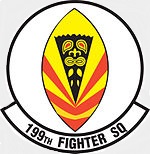Hobby Master HA3117 USAF Convair F-102A Delta Dagger Interceptor - 54-1373, 199th Fighter Interceptor Squadron "Mytai Fighters", Hawaiian Air National Guard, Joint Base Pearl Harbor-Hickam, Honolulu, Hawaii, 1960 (1:72 Scale)
"The Deuce"
- Nickname for the Convair F-102 Delta Dagger
 The Convair F-102 Delta Dagger is an interceptor aircraft designed and produced by the American aircraft manufacturer Convair. A member of the Century Series, the F-102 was the first operational supersonic interceptor and delta-wing fighter operated by the United States Air Force (USAF).
The Convair F-102 Delta Dagger is an interceptor aircraft designed and produced by the American aircraft manufacturer Convair. A member of the Century Series, the F-102 was the first operational supersonic interceptor and delta-wing fighter operated by the United States Air Force (USAF).
The F-102 was designed in response to a requirement, known as the 1954 Ultimate Interceptor, produced by USAF officials during the late 1940s. Its main purpose was to be the backbone of American air defenses and to intercept approaching Soviet strategic bomber fleets (primarily the Tupolev Tu-95) during the Cold War. The aircraft was designed alongside a sophisticated fire-control system (FCS); however, a simplified unit had to be adopted due to development difficulties. It used an internal weapons bay to carry both guided missiles and rockets. On 23 October 1953, the prototype YF-102 performed its maiden flight; however, it was destroyed in an accident only nine days later. The second prototype allowed flight testing to resume three months later, but results were disappointing: as originally designed, the aircraft could not achieve Mach 1 supersonic flight.
To improve its performance prior to quantity production commencing, the F-102 was redesigned, its fuselage was reshaped in accordance with the area rule while a thinner and wider wing was also adopted. Flight testing demonstrated sufficient performance improvements for the USAF to be persuaded to permit its production; a new production contract was signed during March 1954. Following its entry to USAF service in 1956, the F-102 promptly replaced various subsonic fighter types, such as the Northrop F-89 Scorpion, in the interceptor role. The F-102C tactical attack model, equipped with several improvements, including a more powerful engine and Gatling gun, was proposed but not ultimately pursued. A total of 1,000 F-102s were built, both for the USAF and a handful of export customers, including the Hellenic Air Force and the Turkish Air Force.
By the 1960s, USAF F-102s had participated in a limited capacity in the Vietnam War as a bomber escort and even in the ground-attack role. The aircraft was supplemented by McDonnell F-101 Voodoos and, later on, by McDonnell Douglas F-4 Phantom IIs. Over time, many F-102s were retrofitted with infrared search/tracking systems, radar warning receivers, transponders, backup artificial horizons, and modified fire-control systems. Throughout the mid-to-late 1960s, many USAF F-102s were transferred from the active duty Air Force to the Air National Guard, and, with the exception of those examples converted to unmanned QF-102 Full Scale Aerial Target (FSAT) drones, the type was totally retired from operational service in 1976. Its principal successor in the interceptor role was the Mach 2-capable Convair F-106 Delta Dart, which was an extensive redesign of the F-102.
Pictured here is a 1:72 scale rendition of a Convair F-102A Delta Dagger interceptor that was attached to the 199th Fighter Interceptor Squadron "Mytai Fighters", Hawaiian Air National Guard, then deployed to Joint Base Pearl Harbor-Hickam, Honolulu, Hawaii, during 1960.
Now in stock!
Dimensions:
Wingspan: 6-1/4-inches
Length: 11-1/4-inches
Release Date: October 2024
 Historical Account: "Mytai Fighters" - The wartime 463d Fighter Squadron was re-designated as the 199th Fighter Squadron, and was allotted to the Hawaii Air National Guard, on May 24th, 1946. It was organized at Bellows Field, Waimanalo, Hawaii, and was extended federal recognition on November 4th, 1946, by the National Guard Bureau. The 199th Fighter Squadron was bestowed the lineage, history, honors, and colors of the 463rd Fighter Squadron. The squadron was equipped with F-47N Thunderbolts and was operationally gained by Seventh Air Force. Its mission was the air defense of Hawaii.
Historical Account: "Mytai Fighters" - The wartime 463d Fighter Squadron was re-designated as the 199th Fighter Squadron, and was allotted to the Hawaii Air National Guard, on May 24th, 1946. It was organized at Bellows Field, Waimanalo, Hawaii, and was extended federal recognition on November 4th, 1946, by the National Guard Bureau. The 199th Fighter Squadron was bestowed the lineage, history, honors, and colors of the 463rd Fighter Squadron. The squadron was equipped with F-47N Thunderbolts and was operationally gained by Seventh Air Force. Its mission was the air defense of Hawaii.
Bellows Field, which was attacked during the December 7th, 1941, Japanese attack on Oahu, was excess after World War II ended, and it served as home for the Hawaii Air National Guard.
In 1947, the costs to operate Bellows as an active Air National Guard station led the Territorial government to negotiate with the Army about its future. The Army indicated that it wanted to retain the field in a commissioned status but that it had no funds to maintain the field. The Army offered the Aviation Unit of the Hawaiian National Guard joint use of the field provided all maintenance was assumed by the Guard. A settlement was reached to move the 199th to Hickam Field, and to use excess facilities there.


